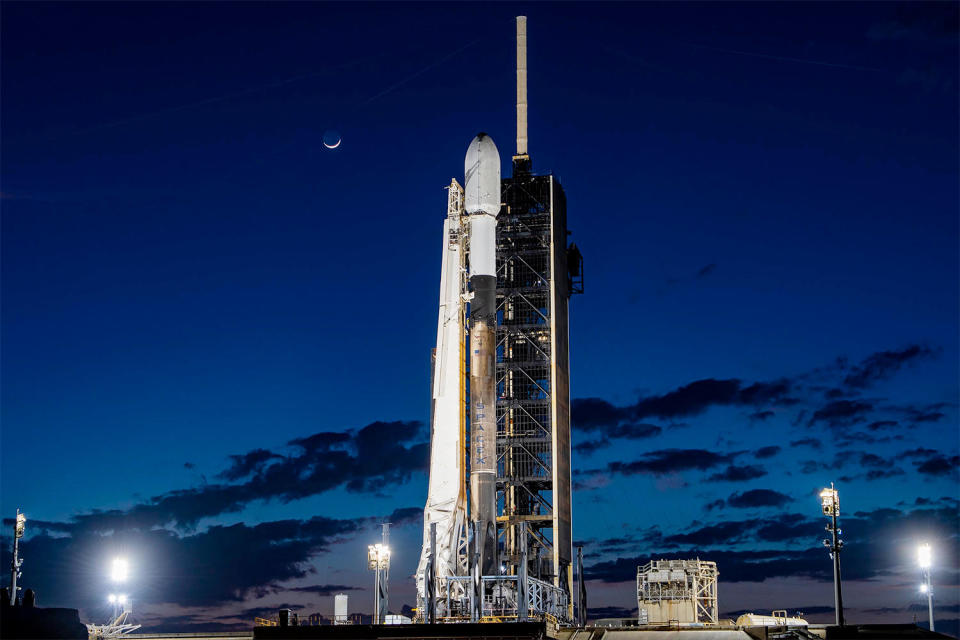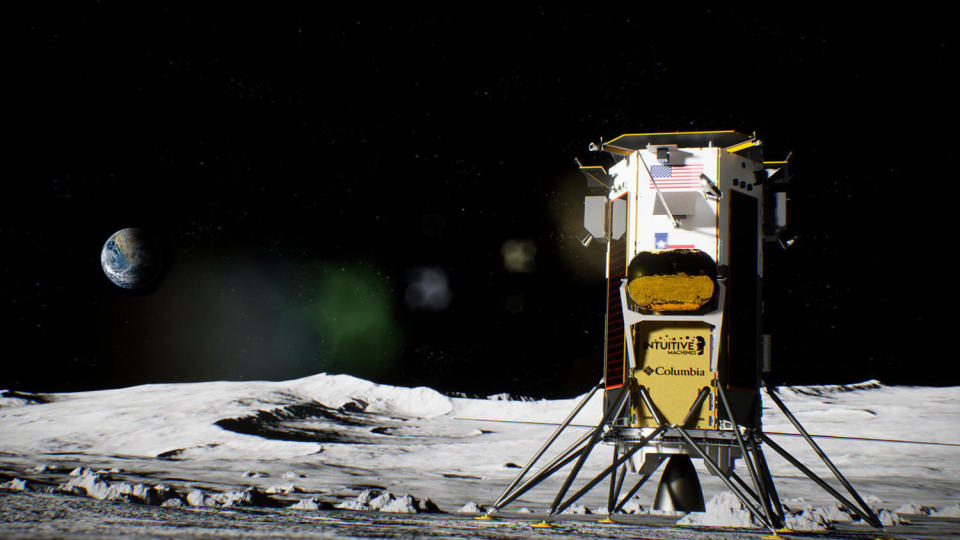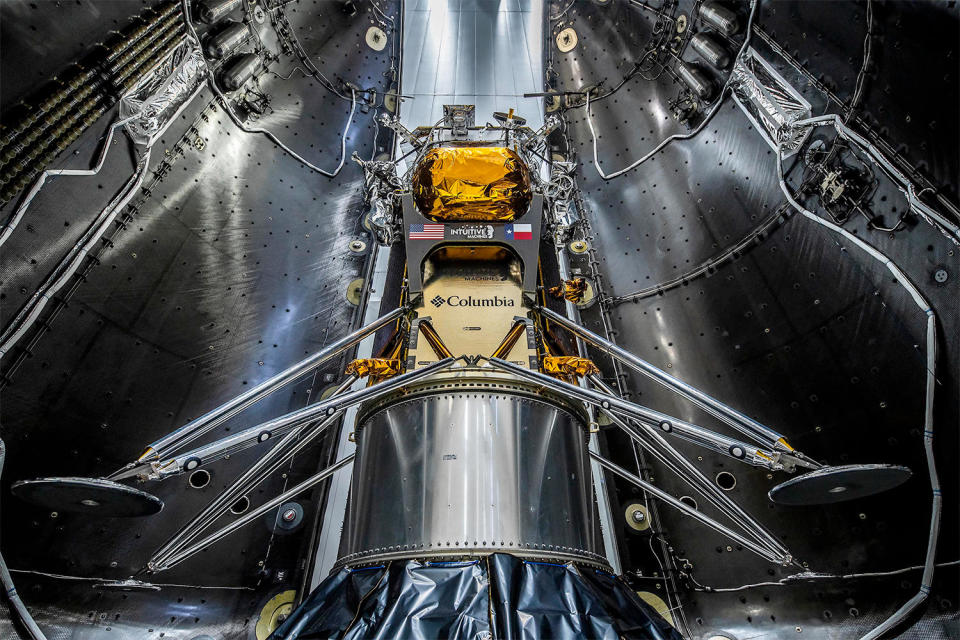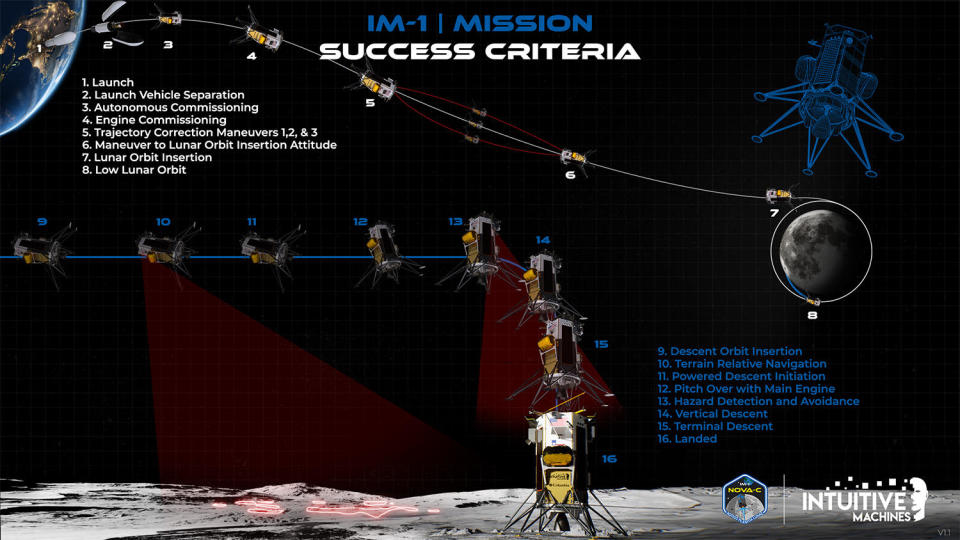SpaceX has prepared a Falcon 9 rocket for launch early Wednesday to send a commercially built robotic lander to the Moon, the first targeted landing near the Moon’s south pole, where NASA’s Artemis astronauts plan to walk within a few years.
The flight came just five weeks after another US company’s failed attempt to land a specially built spacecraft on the moon; it was the third commercial failure in a row.

The fourth such mission is set to lift off from Kennedy Space Center at 12:57 a.m. EST on Wednesday.
If all goes well, the Odysseus lander, nicknamed “Odie,” will touch down about 300 kilometers from the moon’s south pole on February 22, using a high-power 3D-printed main engine that burns liquid oxygen and methane propellants, a first for deep space. mission.
SpaceX implemented extensive modifications to cool and direct cryogenic fuels into the Falcon 9’s nose fairing and then into the lander’s tanks during the rocket’s countdown. Dress rehearsals were held late last week to verify that the system would work as it should.
“SpaceX is very proud to be a part of this historic special mission to the moon,” said former NASA administrator Bill Gerstenmaier, who now works for SpaceX. “Loading the vehicle with liquid oxygen and liquid methane is not a trivial task. We modified the Falcon’s second stage to accommodate it. … The Falcon 9 rocket is ready to fly.”
The flight followed the ill-fated Jan. 8 launch of Peregrine, another commercial lunar lander built by Pittsburg-based Astrobotic. drive system failure shortly after takeoff. The mishap derailed the first U.S. moon landing since the Apollo program’s last flight more than 50 years ago.


Houston’s Intuitive Machines, the maker of Odysseus, now hopes to have that honor.
“This is an extremely embarrassing moment for all of us at Intuitive Machines,” said Trent Martin, the company’s vice president of space systems. “The opportunity to return the United States to the moon for the first time since 1972 is an engineering marvel that requires a hunger to explore.”
“We are not ignoring the challenges ahead,” Martin added. “Any venture into uncharted territory carries risk, but the willingness to accept risk and go beyond our comfort zones pushes us forward and encourages innovation. … Now let’s go make history.”
Odysseus carries six commercial payloads, including six NASA instruments, as well as sculptures, proof-of-concept cloud storage technology, an astronomical telescope, and a student-built camera suite that will drop to the surface ahead of the lander to photograph its final descent.
NASA experiments include a device to study the charged particle environment on the lunar surface, a device to test navigation technologies and downward-looking stereo cameras designed to photograph how the lander’s engine exhaust disrupts the soil at the landing site.
Also on board: an innovative sensor that will use radio waves to accurately determine how much cryogenic propellant is left in a tank in the weightlessness of space; This technology is expected to be useful for downstream lunar missions and other deep space exploration.


Falcon 9 is expected to launch the lander into a lunar orbit. But getting into lunar orbit and landing on the surface will be up to Odysseus and the Intuitive Machines flight control team in Houston.
A key milestone is expected to occur 18 hours after launch, with a test firing or commissioning of the lander’s main engine, which will help controllers calibrate the vehicle’s performance in space. After that, up to three orbit correction maneuvers are planned to precisely adjust its course relative to the moon.
It will take Odysseus eight days to reach his destination. Flying behind the moon and without contact with flight controllers, the lander’s main engine will need to fire “blindly” for seven minutes to place the vehicle in a 62-mile-high circular orbit that will carry it at an 80-degree angle over the landing site. southern latitude.
During 12 trips around the moon, flight controllers will check the lander’s systems before beginning its final descent to relatively flat terrain near a crater known as Malapert A. To ensure a safe landing, the main engine will need to reduce the spacecraft’s speed slightly. 4,000 mph.
The descent will begin with the firing of a small rocket 75 minutes before landing to lower the low point of the orbit to an altitude of about 6 miles. The spacecraft will then remain on shore for about an hour before the engine is reignited to begin a powered descent to the surface.
Descending to an altitude of approximately 30 kilometers, Odysseus will shift from horizontal to vertical and drop to just under 4 miles per hour. When the spacecraft drops below 30 meters, the “EagleCam” imaging system created by Embry-Riddle University students will drop and attempt to photograph the vehicle’s final descent from the side.
By the time Odysseus reaches 33 feet above the surface, the main engine will have been throttled to its planned descent speed of just 2.2 mph (walking pace for the elderly).


Intuitive Machines says it will take about 15 seconds for flight controllers to confirm touchdown. Data recorded during the descent, including photos from the lander’s smoke observation cameras and the deployed EagleCam, will then be transmitted back to Earth.
Odysseus and his experiments are expected to operate at the landing site for about a week before the sun sets and solar power is cut off. The spacecraft is not designed to withstand the extremely low temperatures of the two-week lunar night.
“Landing on the Moon is really difficult,” said Joel Kearns, NASA’s deputy administrator for exploration. “I think people have made different attempts at this over the last year and it’s really hard. There’s no air on the moon, you can’t use a parachute, you have to use a rocket to slow down.”
“Intuitive Machines have chosen some really innovative techniques that they use in their propulsion systems,” Kearns said. “They have a lot of cool things to show off. This means they’ll be doing a lot of things for the first time.”
Only the United States, Russia, China, India and Japan have successfully landed on the moon’s surface, and Japan’s membership in this exclusive club comes with an asterisk: The “SLIM” lander failed to make it when it rolled over during landing on January 19. all objectives of the mission.
Between 2019 and last January, three privately funded lunar landers were launched, one from an Israeli nonprofit, one from a Japanese company, and Astrobotic’s Peregrine. All three failed.
Peregrine and Odysseus were both powered in part by NASA’s Commercial Lunar Payload Services program, or CLPS (pronounced “clips”), designed to encourage private industry to develop transportation capabilities that NASA could then use to deliver payloads to the Moon. financed.
The agency’s goal is to help kick-start the development of new technologies and collect the data Artemis astronauts will need. It plans to land near the moon’s south pole late next decade.
The agency spent approximately $108 million for the Peregrine mission and $129 million for the Odysseus instruments and transportation to the moon.
“These are not NASA missions, they are commercial missions,” said Susan Lederer, CLPS project scientist at Johnson Space Center. “These commercial companies will bring our devices with them throughout the journey, providing power, data and [communications] to us.
“With the commercial industry comes a competitive environment, which means our upfront investment ultimately achieves much more for much less cost. So instead of one mission per decade, it allows for up to 10 commercial missions to the Moon per decade.”
However, the low cost of the CLPS mission also brings with it higher risks. Lessons learned from Peregrine will flow into the development of the company’s next lander and other CLPS missions, scheduled for launch later this year.
“We will learn what doesn’t work, test many technologies, perform experiments at lower cost and significantly faster than a traditional NASA mission,” Lederer said. “This will allow us to prepare for Artemis more efficiently.”
Ministry of Foreign Affairs issues travel warning for Bahamas and Jamaica
Investigation after shooting at Joel Osteen’s Lakewood church in Houston
Biden asks House of Representatives to pass foreign aid bill